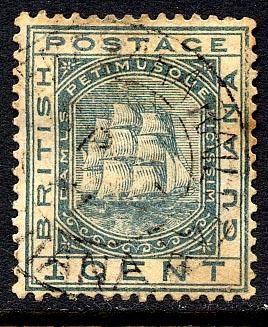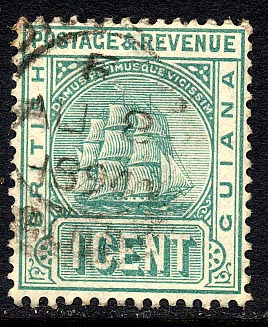


In 1925 it was stated by the late Capt. J. A. Tinne, M.P., in an interview, that a photograph of one of the oldest sailing ships of his firm—Sandbach, Tinne and Company—was taken as a model for the medallion on the British Guiana stamps, where, it keeps company with the portrait of the late King George V. These stamps were first issued in 1913, but the design, without the portrait, dates back to 37 years earlier, for the same picture of the full-rigged ship Sandbach, but in a different frame, was used for the stamps issued in 1876.
A different picture of the vessel appeared on three stamps, 6 cents, 24 cents and 48 cents, 13 years earlier still and the same picture appeared on more stamps in 1866. British Guiana stamps issued before 1863 and showing sailing ships do not depict the Sandbach.
This 435-ton frigate-built ship was constructed at Liverpool in 1825 for Mr. Samuel Sandbach, of Sandbach, Tinne and Company, of that city. The Sandbach was an extremely popular ship on Merseyside and was one of the great vessels of Liverpool, sailing regularly out of the port for half a century. It is reported that at one period of her career the bells of the seamen's church, the Parish Church of St. Nicholas, used to be rung when she arrived home in the Mersey. The late Capt. Angel, her last master, has recorded that she was the first sailing ship to be fitted with and to trust entirely to chain cables instead of rope hawsers, and the first to have iron caps to masts and bowsprit.
The Sandbach's grand period of service terminated in 1874, when her owners decided to have their famous old ship broken-up, although her timbers were quite sound, rather than sell her out of their service. The ship's draft was too great to cross the bar at Demerara and she had always to be loaded and unloaded by lighters while anchored 10 miles outside the port. When freights were plentiful this was an economic proposition, but towards the end of the 'seventies' conditions changed and the use of lighters proved too expensive to be commercially practical. So the old vessel was consigned to the shipbreakers. She was broken-up by Clover and Clayton at Birkenhead in 1878, and many people who had connections with her were presented with teak souvenirs from her timbers.
The business of the Sandbach's owners was first established in Demerara in 1782 by Mr. Mclnroy. He was joined in 1790 by Messrs. 0. Robertson, Charles Parker and Samuel Sandbach (the last-named had previously been in business in Grenada), and the firm adopted the name of Mclnroy, Sandbach and Company in Demerara. A Glasgow office was opened about the same time under the style of Mclnroy, Parker and Company, but was closed later, and the headquarters of the firm transferred in 1813 to Liverpool, where it has existed ever since that date under the name of Sandbach, Tinne and Company.
When Demerara became British in 1813 Mr. Samuel Sandbach—who, incidentally, was Mayor of Liverpool about 1831—invited Mr. P. F. Tinne who had been Government Secretary of that Colony under the Dutch Government, to become his partner in this country. Sandbach, Tinne and Co's first ship was the Demerara, which traded between Demerara and this country in the early years of the 19th century. This vessel was the pioneer of a fleet which sailed under Letters of Marque and carried passengers between Demerara and Liverpool for many years before steamers were used.
First ship which the firm had specially built for speed was the Ailsa, a full-rigged composite clipper of 1,061 net register tons, built by Chas. Connell and Company, of Glasgow, in 1870. She was one of the prettiest vessels ever launched and could sail like a witch. She was first put into the China tea trade, In which she immediately distinguished herself by her quick passages, and later was transferred to the coolie service between Calcutta and the West Indies, in which she remained until she was sold to Arab merchants in Calcutta who employed her in carrying pilgrims and merchandise to the Persian Gulf. Her first, master was Capt. Richard Russell, of Egremont, who had come from the firm's Rona.
When the Jura was launched in 1875, Capt. Russell left the Ailsa and took the new vessel. The Jura was a beautiful ship built specially for the coolie trade by Connell and Company, and Capt. Russell made some splendid passages in her. He died on board in 1895 just as the vessel was entering New York. Mrs. Russell Taylor, Lady Mayoress of Liverpool in 1921, was a daughter of Capt. Russell.
The Sheila and the Brenda were the last two vessels which Sandbach, Tinne and Company had built specially for the coolie trade, as it became evident that eventually steamers would be employed in lieu of fast sailers. Others of the firm's vessels in this service were the St. Kilda, Pandora, Apelles, British Nation and British Statesman, which were all fair sailers.
Capt. W. L. Rosseter, of Lyrninge, Hythe, who was well known in Liverpool and who was master of the St. Kilda, British Nation, Columba and Brenda, tells me that once at Calcutta there were no fewer than nine ships of the firm lying within sight of each other, which was very unusual even for those days.
Capt. Hearn, of the firm's Genista, and his wife had a front seat at the Battle of Manila, as the Genista was lying in the harbour during the engagement between Admiral Dewey's squadron and the Spanish Fleet. After the sale of the Genista, Capt. Hearn took command of the Martaban, a large four-master which had just been launched on the Clyde for the British and Eastern Shipping Co., Ltd. He took her to the Cape and thence to Java, where she loaded sugar for home. From the time she left Java she has never been heard of and there has never been the slightest clue to her disappearance.
Since 1861 the firm has been under the title of Sandbach, Parker and Company in Demerara. A Canadian branch was opened in Montreal in 1909 under the title of the West India Co., Ltd., and in 1923 a branch was opened in Trinidad under the name of Sandbachs (Trinidad), Ltd.
Stamps from 1876 to 1918. Sea Breezes 2/50
